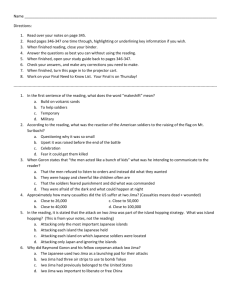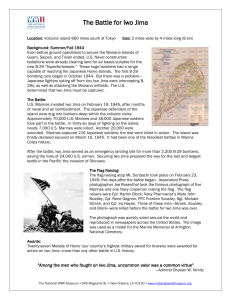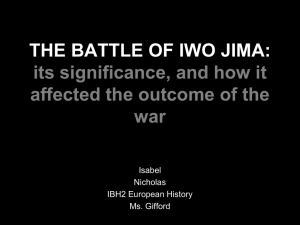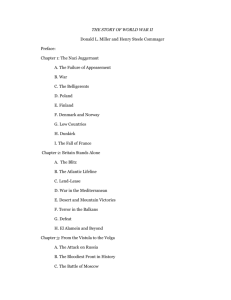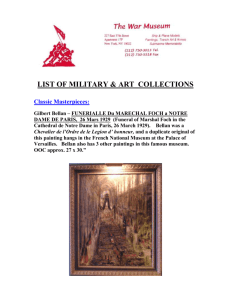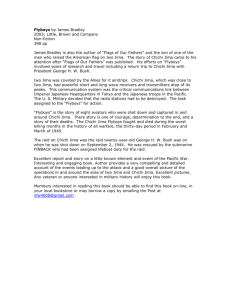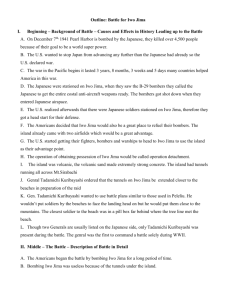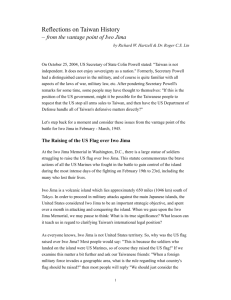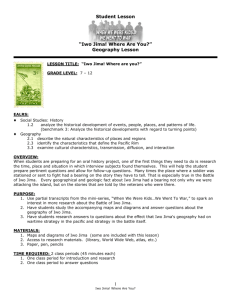Flags of our Fathers, direct
advertisement
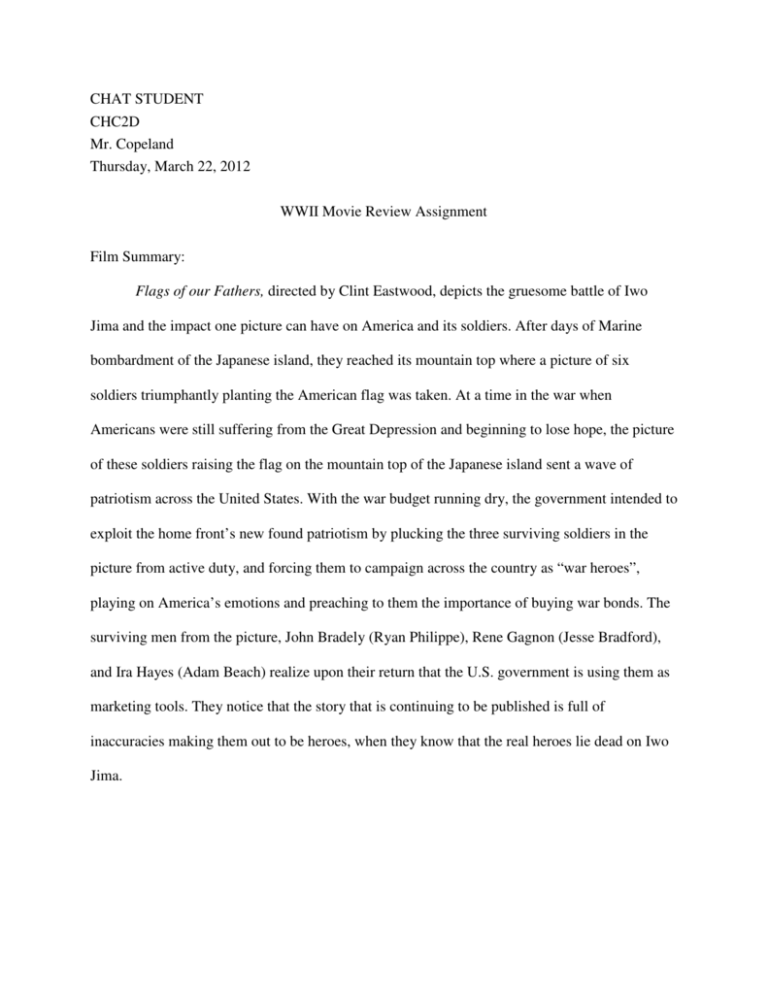
CHAT STUDENT CHC2D Mr. Copeland Thursday, March 22, 2012 WWII Movie Review Assignment Film Summary: Flags of our Fathers, directed by Clint Eastwood, depicts the gruesome battle of Iwo Jima and the impact one picture can have on America and its soldiers. After days of Marine bombardment of the Japanese island, they reached its mountain top where a picture of six soldiers triumphantly planting the American flag was taken. At a time in the war when Americans were still suffering from the Great Depression and beginning to lose hope, the picture of these soldiers raising the flag on the mountain top of the Japanese island sent a wave of patriotism across the United States. With the war budget running dry, the government intended to exploit the home front’s new found patriotism by plucking the three surviving soldiers in the picture from active duty, and forcing them to campaign across the country as “war heroes”, playing on America’s emotions and preaching to them the importance of buying war bonds. The surviving men from the picture, John Bradely (Ryan Philippe), Rene Gagnon (Jesse Bradford), and Ira Hayes (Adam Beach) realize upon their return that the U.S. government is using them as marketing tools. They notice that the story that is continuing to be published is full of inaccuracies making them out to be heroes, when they know that the real heroes lie dead on Iwo Jima. Historical Significance: The Battle of Iwo Jima and the events following it had a profound impact on the American people. The U.S. army had never seen such brutal warfare that resulted in the slaughter of such large quantities of American soldiers. The 36 day assault on Iwo Jima resulted in 26,000 American casualties, 6,800 of whom died (“Battle For Iwo Jima, 1945”). These numbers are so significant, because this was the only U.S. Marine battle of WWII where the number of American casualties exceeded that of the Japanese (“Battle Of Iwo JimaJapanese Defense”). Due to the lack of movement on Iwo Jima post-shelling, the U.S. suspected that they had already eliminated most of the Japanese forces from their bombardment at sea. However, once the Marines arrived on the beach they were gunned down by Japanese soldiers peaking out of their heavily fortified network of bunkers, hidden artillery, and 18 km of underground tunnels (O’Brien). This element of surprised added to the horror and deadliness of the battle. However, after Iwo Jima was captured and the battle was done, it was used as an emergency landing strip for damaged U.S. aircrafts. The battle of Iwo Jima is historically significant not only because of its obscenity, but because it resulted in saving the lives of 27,000 American soldiers who made unscheduled landings on the island (“Battle For Iwo Jima, 1945”). While the battle of Iwo Jima itself exceeded anything the U.S. had ever seen before, it was perhaps the notorious picture of six American soldiers raising the flag that really “hit home”. The picture was taken several days into the battle, when the Americans captured Mount Suribachi, which was believed to play a pivotal role in capturing the island. Immediately after the striking picture was developed hundreds of newspapers obtained the image and it "was distributed by Associated Press within seventeen and one-half hours after Rosenthal [photographer] shot it—an astonishingly fast turnaround time in those days (Centre For American History News). This picture had such a profound ability to evoke emotion, that President Franklin D. Roosevelt decided to use the picture and the three surviving soldiers in it, as the symbol for the upcoming war bond drive. Bradley, Gagnon, and Hayes, were forced to go on a cross country tour that raised $26.3 billion, twice the tour’s goal (Bradley & Powers 294). This one picture, and the men in it, had the ability to instill enough patriotism in all of America, that they willingly drained their pockets in support of their soldiers. It was this support from the home front that brought the war to a victorious end later that year. Without this picture the war bond drive would have been nowhere near as successful as it was, and with the American war chest running low, perhaps the outcome of the war would have been different. This historical event shows that a country can best be swayed by playing on its emotions through the delicate art of propaganda. Film Critique: Flags of Our Fathers attempts to give viewers a realistic look at the Battle of Iwo Jima and the true story behind the image that captivated the nation: Raising the Flag on Iwo Jima. For years, the U.S. government happily let Americans invent and believe stories of what had happened preceding and subsequent to the raising of the flag. The whole country was fed a biased and propagandistic account, glorifying the men in the picture as war heroes. This film does not depict the valiant story that Americans wanted to believe for so long, but it allows the viewer to see the experience that Bradley, Gagnon, and Hayes truly had throughout the war and thereafter. One could say that this movie, focused on the soldiers who raised the flag, is biased because of that. However, the only way to genuinely understand what these men went through is to step into their shoes. Flags of Our Fathers is widely known as one of the most historically accurate war films of its generations, according to critics (French). Eastwood is often commended for his ability to stay true to the actual events that took place on and after Iwo Jima (Castagnera). Considering the movie was based on a non-fiction book written by the son of flag raiser; John Bradley, it was fairly easy to do so as long as Eastwood did not stray from the book. Flags of Our Father brings truth to the myth surrounding the flag raising. The flag was planted to signal to the rest of the American troops on the island that they had secured Mount Suribachi, not that they had captured Iwo Jima. In fact, the flag being raised in the picture was actually the second flag that was raised that day, and Flags of Our Fathers makes that clear and one of the central conflicts throughout the film. The first flag was small, and raised by another platoon. Bradley and Hayes’ platoon was already on top of Mount Suribachi laying telephone wire, when Gagnon was sent up to retrieve fresh radio batteries with orders to plant a new and larger flag. For years there was controversy as to which Marines were actually in the photo, but Eastwood brings a precisely accurate truth to the screen. Eastwood is widely commended for his ability to show the perspective of all the characters in the film. He gives the audience a painful sense of survivours’ guilt and how Bradley, Gagnon, and Hayes felt about being used as marketing tools. While Gagnon was happy to leave Iwo Jima for the war bond campaign, Bradley and Hayes did not want to desert their comrades who are still dying on Iwo Jima, only to come home to a hero’s welcome. Bradley and Hayes were extremely uncomfortable being called heroes, because they had not paid with their lives as many of their friends did. The film shows that this welcome home magnifies the effect of survivours’ guilt and tortures the minds and hearts of Bradley and Hayes. Eastwood weaves in an underlying theme, relating to Native American flag raiser, Ira Hayes. Throughout the film, Hayes is constantly reminded of his heritage and teased by people who are ignorant to his culture. He was an upstanding person and loyal to his platoon, and did not want to leave them to go on the war bond campaign. On the tour, Hayes is refused service at a bar due to a “No Indians” policy. Eastwood emphasizes how twisted it is that a man is willing to serve his country in war, but his country is not willing to serve him a drink at a bar. The film displays how the U.S. government was pressured to fund the war and how they shamelessly exploited the photo and the surviving soldiers. Eastwood suggests that the government viewed Bradley, Gagnon, and Hayes as tools who could be used to pluck at the heartstrings of Americans and get them to open their pockets for war bonds. In order to do so, they had to fabricate a story that would make the surviving soldiers seem like war heroes. To them, it was simply “showbiz”. Eastwood even shows how easy it was for the American people to yield to the propaganda, by creating moving scenes that even invoke patriotism in the viewers. The film has received criticism that it lacks the African American perspective from the likes of director, Spike Lee. He has scolded Eastwood for not using any African American actors in Flags of Our Fathers. Eastwood replied saying that the movie is about the flag raisers, and none of the flag raisers happened to be Black. He thought that it would be foolish to throw an African American actor in the film for the sake of it, when it was not historically accurate (Brunton). Spike Lee’s accusation was, in fact, false; there are Black Marines in several scenes of the film. Flags of Our Fathers excelled at emphasizing the brutality and grisliness of the battle of Iwo Jima. The costume, special effects, flawless acting, and true to life combat sequences, are what made this film so realistic. Viewers truly feels like they are watching a war unfold in front of them. “Hollywood” allowed Flags of Our Fathers to reach its potential. The special effects in the battle sequences gave a totally realistic feel to the battle, a feel that could not have been achieved without a team of special effects experts. For the most part, Eastwood steered clear of the tacky, Hollywood feel in order to display the situation in its rawest form. However, humour, companionship, and sorrow were injected throughout the film to show the viewers the bond that these men had with one another and the difficulties Bradley, Gagnon, and Hayes faced. Director, Clint Eastwood, pulls out all the stops to achieve the most historically accurate, unbiased, recount of the events that took place on Iwo Jima and after. Works Cited "Battle for Iwo Jima, 1945." The Navy Department Library. 1960. Web. 18 Mar. 2012. "Battle of Iwo JimaJapanese Defense." Web. 18 Mar. 2012. Bradley, James, and Ron Powers. Flags of Our Fathers. New York: Bantam, 2000. Print. Brunton, Richard. "Filmstalker: Eastwood Defends Historical Accuracy." 2008. Filmstalker. Web. 21 Mar. 2012. Castagnera, Jim. “Flags of Our Fathers.” The History Place Movie Review." 2006. Web. 21 Mar. 2012. The Center for American History News. "Centre Receives Rare Print of Rosenthal Iwo Jima Photo." The University of Texas, Austin. 2005. PDF file. French, Lisa. “Historical Accuracy.” Flags of Our Fathers: a fan site." 2008. Web. 18 Mar. 2012. O’Brien, Cyril J. "Iwo Jima: A Remembrance." Military.com. Web. 18 Mar. 2012.
